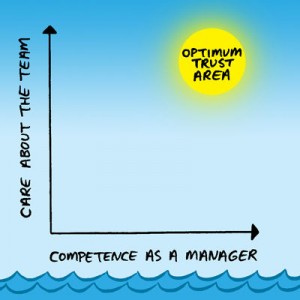Don’t go it alone. Give Trust.
“I don’t care how talented you are, if you cannot work as part of a team, you cannot reach ultimate success. With a talented team that wants to work together, you can accomplish anything. I have taken very talented smart people who did not play on a team and shown them the door.” – Joe Tucci, CEO EMC
The temptation is great to take over the process, assignment, or whatever task, and either lead or wholly do it yourself, knowing with self-confidence that if you do it, it’ll get done ‘right.’ Or at least the way you want it done. And maybe you will accomplish that specific task to your satisfaction. But at what expense? If you are responsible for working with multiple people and projects, your myopic diversion means you aren’t spending time and energy in what matters strategically, and then of course – what message does that send about trust? Rosabeth Moss Kanter wrote an entire book about the intersection of confidence and trust, and in it, she examines what the winning teams have in common (trust and respect), and what short-lived winning teams have (Prima Donas or luck).
In my experience both as an entrepreneur and lead collaborator, if any project hits the rails it’s either because of my own lack of communication, or lack of support and follow-through, not because the people I trusted where incapable or unwilling. Here’s what I suggest (and Julie Gebauer and Dan Lowman back it up with the numbers in their book.)
- Show the entire picture. Imbue Purpose: No one ever cares for perceived make-work activities that they feel have no relevance or value in the major game plan. Explain why the task matters in the whole story and people will feel part of something larger and important.
- See it through: Check in regularly with a little “how can I help” attitude which conveys that you didn’t just check out and expect that a package will arrive on deadline day. Yes, set clear deliverable expectations, but stay with it and convey the attitude that everyone is on board to support and reassure success.
- Don’t take over: When watching the project unfold, resist any urge to jump in with a “I’ll just do it myself” attitude. That don’t fly. This is a key part of the give-trust equation.
- Roll up your sleeves: When checking in on progress, find points of inflection and challenge and offer solutions that you are willing to contribute to. Then do it. Play your part. As Terri Kelly, CEO of W.L. Gore says “No one may commit another.” Communicate that this is as much your deal as theirs.
- Bring in the resources: This is an opportunity to reach deep into your own network – internal or external – to bring talent and expertise that can aid the solution. But be careful not to over-engineer. If you are at, say, a design point, then tap a graphic artist who can aid just enough to allow the team champion to leverage that talent and bring the project to completion. Don’t make it about the sourcing in such a way as to hijack the project. That sounds to anyone like, “Well, looks like you couldn’t do it. I guess we’ll bring in a pro now. Thanks for your efforts thus far.” Remember, you trusted them as the pro. Treat them like a pro and give ownership to the project.
In Julie Gebauer and Dan Lowman’s book, Closing the Engagement Gap, they show an internal EMC study demonstrating 93% of EMC people enjoy working with their coworkers. Since this is true at EMC and elsewhere, facilitate and enable, but dear friends, please don’t get all Prima donna about it.


